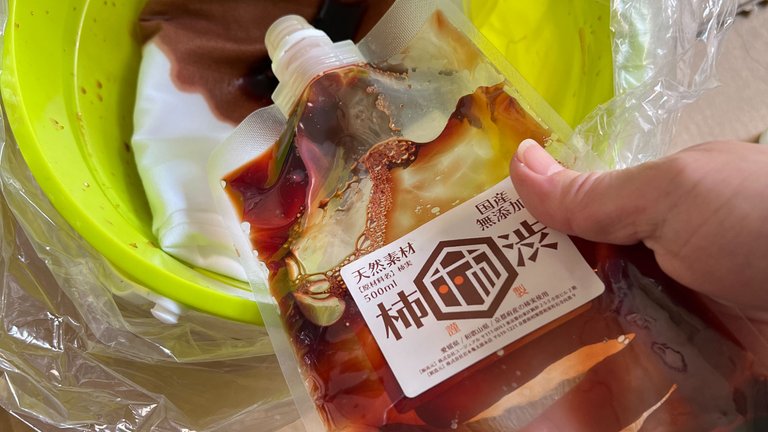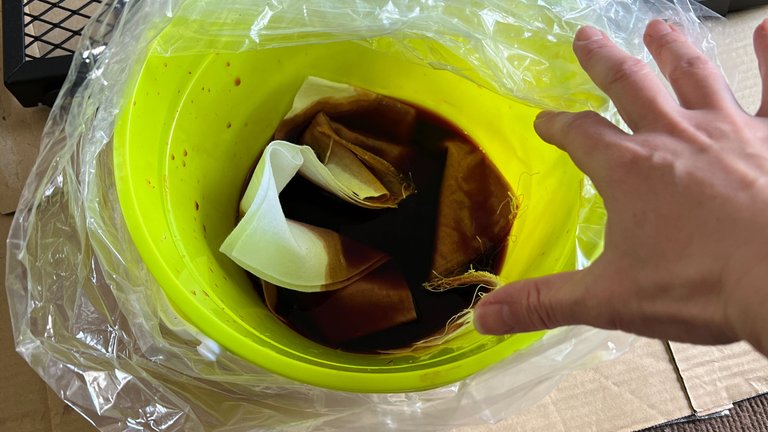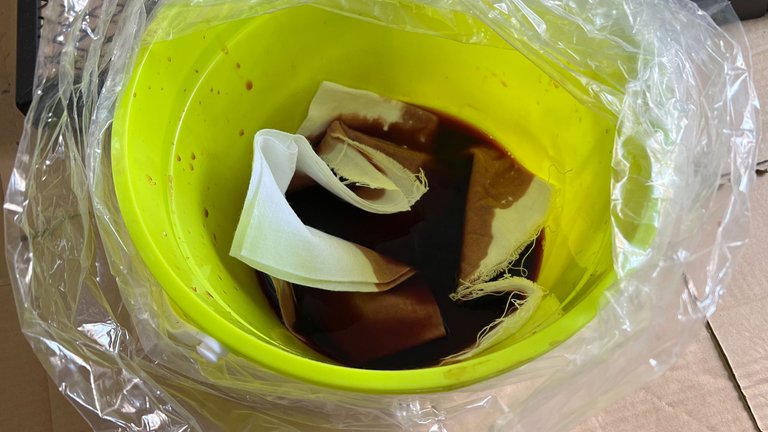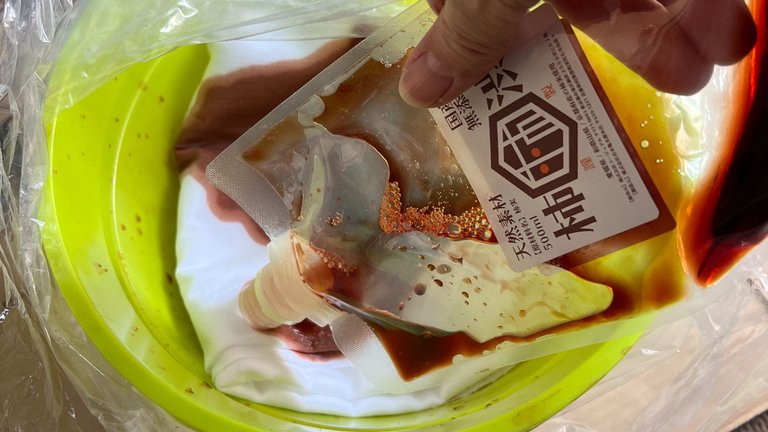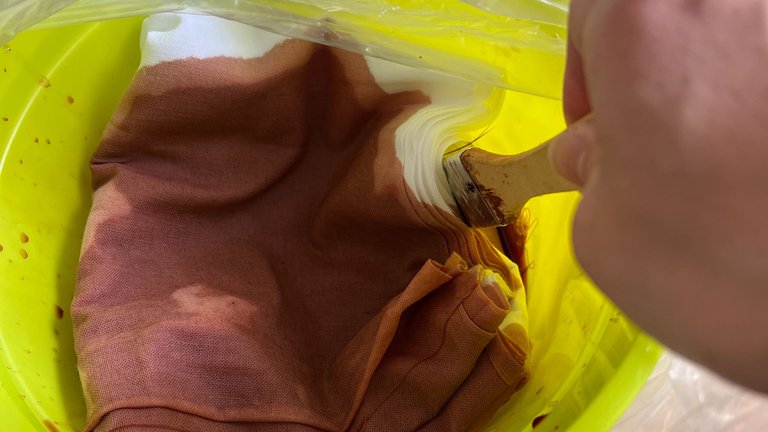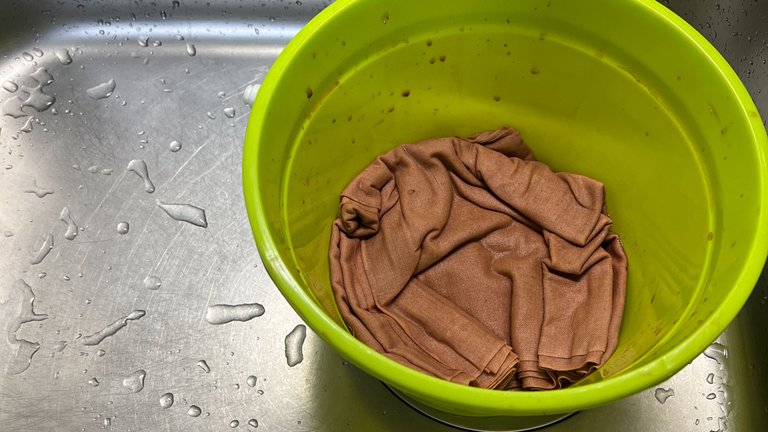Finally, persimmon tannin dyeing of cotton cloth begins/いよいよ木綿の布の柿渋染め開始/[ENG/JPN]
The article in Japanese is in the second half.★日本語の記事は後半に。
I recently dyed some shelving boards with persimmon tannin. Here is the article of that time.
Shelves painted with persimmon tannin/棚板に柿渋塗り/[ENG/JPN]
I kept the persimmon tannin I used at this time and carried out my plan to dye bleached cotton cloth.
I had already been thinking about this plan for several months, wondering when to do it.
The use of the cotton cloth dyed with persimmon tannin is to use it as a cloth in the kitchen, and also to squeeze it tightly in place of plastic wrap when heating food in the microwave.
I will also sew myself a bag and use it to store my precious camping gear.
In order to do the persimmon dyeing myself this time, I did a lot of research on the Internet for information from experts.
According to them, it is best not to use this kind of "soaking" method because it often fails, and if possible, it is best to keep the work spread out and taut, and apply it several times with a brush.
The reason was that if I soaked it in a bucket like this, uneven coloring would occur and it would not be dyed evenly, which would not result in the ideal piece.
I think that the uneven colors are not a problem at all for what I want to make, and in fact, I think that the uneven colors are better for the taste and the natural gradation of the colors.
So I decided to use this method this time because it saves working space.
I also used all of the persimmon tannin solution that was left over from the last time I applied it to the shelves.
There was a little left over after opening the package, so I was glad to be able to use it all up, as it would have tarnished the cloth if I didn't.
The cloth soaked up just fine, and I figured this would dye it well to start with.
How long to soak the cloth in the solution... "It depends on each person's preference on how thick he/she wants to dye the cloth," so even if it is a specialized information article, it does not specifically say how many hours to soak the cloth in the solution. So, I tried soaking them for 48 hours, or two full days.
It has been two days.
↓
Hmmm...
It looks like it is dyed well.
However, this time we did not add any kind of "fixing agent" at all. Therefore, the color is not fixed to the cloth as it is as seen by our eyes.
I was not sure whether I should just squeeze it lightly or wash it with water...but I washed it with water just once as a trial.
After all, about half of the color has washed off. Oops.
But for me, I am satisfied with just a hint of persimmon tannin brown, so I'm OK with that.
What I'm hoping for is not so much the color depth, but rather that the antiseptic and insect repellent properties of the persimmon tannin will allow the cotton cloth to last longer, and the deodorant, antibacterial, and antiviral effects will protect foodstuffs.
If it is dyed this dark, we can expect a lot from it.
And I still found areas that were not evenly stained.
There are some areas in the center that remain white. This is because air bubbles must have remained here, and the persimmon tannin dye did not spread.
I see, you have to be careful about these things when soaking in a bucket.
(No problem at all if this is the application I am going to use this time)
After this, the process of "drying in the sun" seems to be critical, so I went to the balcony to dry it out. The rain that had just stormed has stopped, and the weather seems to recover after this.
I am looking forward to using it in the kitchen and at the campsite.
There is an artist who makes various kitchen utensils with kakishibu dyes, and I have been looking at her Instagram and there are many wonderful things.
She makes bags for storing grains, aprons, and bags for carrying lunch boxes, taking advantage of the insect and mold resistant properties of persimmon tannin.
I recently saw a very dark-colored cotton apron made with iron catalyst by one of his works.
It was a very dark black color, but it wasn't pitch black; it was dyed a deep natural color, and even though it was an Instagram photo, I was mesmerized for a while.
I don't make them for sale and I don't intend to go to that extreme, but if this dyeing is successful, I will definitely want to try it again.

■diary with a few words
There is a saying in Japan, "Three days of clear skies in spring.
It is said that the westerly winds flowing over the Japanese archipelago are stronger in spring than in other seasons.
Because of this, high and low pressure systems move so fast that "high pressure stays overhead for a while and clear skies do not often last".
The phrase "sunny days in spring don't last for three days and the weather changes quickly" is used to describe this, but this spring the weather is really changing at a dizzying pace.

Japanese★ここから日本語でお送りいたします。
先日、私は柿渋で棚板を染めました。その時の記事はこちらです。
Shelves painted with persimmon tannin/棚板に柿渋塗り/[ENG/JPN]
この時使用した柿渋を残しておいて、晒し木綿の布を染める計画を実行しました。
もう、この計画は数ヶ月前からいつやろうかずっと迷っていました。
柿渋で染めた木綿の布の用途は、キッチンで布巾として使う他、電子レンジで食品を温める時にラップの代わりに固く絞って使います。
また、私が自分で袋を縫って、私の大切なキャンプ道具を収納するのに使います。
今回、自分で柿渋染をするに当たり、専門家の情報をインターネットで色々と調べました。
それによると、このような「漬け込み」は失敗が多いのでやめた方がよく、出来れば広げた状態でピッと張りを持たせた状態をキープして、刷毛で何回かに分けて塗るというのがベストだとのことでした。
なぜなら、このようにバケツに入れて漬け込むと、色むらの発生が酷くなり、均一に染まらないので、理想の作品にならないというのが理由でした。
私が作りたいものは、色むらがあっても全く問題なく、むしろ色むらがあった方が味わい深く、天然のグラデーションが発生して良いのでは無いかと思うくらいです。
ですので、作業場所も節約できますし今回はこの方法を採用しました。
前回棚板に塗る時に余っていた柿渋の液も全部使いました。
開封して少し残っていたので、このままでは変質してしまうし、使い切ることができて良かったです。
程よく布が浸り、これでまずは良く染まると考えました。
どれぐらいの時間をこのまま漬け込むか…「どれぐらいの濃さに染めたいかは、各自の好みによる」ということで、専門情報記事であっても、具体的に何時間漬け込む、ということは特に書かれておらず、今回は試しに48時間、つまり丸2日間漬け込んでみました。
2日経ちました。
↓
ふむふむ。
よく染まっているように見えます。
ただし、今回は「定着剤」のようなものを全く添加していません。ですからこの目で見たままの色がそのまま布に定着しているわけではないのです。
軽く絞るだけにするか、水洗いをするか…迷いましたが、試しに1回だけ水洗いをしてみました。
やはり半分くらい色が流れ落ちてしまいました。あらら。
でも、私としてはほんのりと柿渋のブラウンが効いていれば満足なので、これでOKです。
そして、私が期待しているのは色の濃さよりも、柿渋の持つ防腐、防虫の機能で木綿の布を長く使えるようにし、尚且つ消臭、抗菌、抗ウイルスの効果で食品を守ることです。
これくらい染まっていれば期待ができそうです。
そしてやはり均等に染まっていない部分を発見しました。
中央にいくつか白いままで残っている部分があります。これはきっとここに空気(気泡)が残ってしまっていて、柿渋の染料が行き渡らなかったのでしょう。
なるほど、バケツに漬け込む場合はこういうことに気をつけなければいけませんね。
(今回の私が使おうとしている用途であれば全く問題はありません)
この後は「太陽に当てて干す」という工程が重要ですので、ベランダに干してきました。ちょうど嵐のように降っていた雨が上がり、この後天気は回復するようです。
キッチンやキャンプ場で使うのが楽しみです。
柿渋の染め物で色々なキッチン用品を作っておられる作家さんがいて、その方のInstagramを見ていると、素晴らしいものがたくさんあります。
柿渋の持つ防虫、防カビの機能を生かして、穀物類を保存する袋を作ったり、エプロンを作ったり、お弁当を入れて持ち歩くバッグを作ったりされています。
その方の作品で、先日、鉄触媒を使った非常に濃い色の木綿のエプロンを見ました。
とても濃い黒い色なのですが、真っ黒ではなく、深い自然の色に染められていて、Instagramの写真なのにしばらく見惚れてしまいました。
私は売り物を作るわけでは無いしそこまで極めるつもりはないですが、今回の染色が成功したら、ぜひまたやってみたくなりそうです。

■ひとこと日記
日本には「春に三日の晴れなし」という言葉があります。
春は日本列島の上空を流れている偏西風が他の季節に比べて強いんだそうです。
そのため、高気圧や低気圧の移動速度が速くて「高気圧がしばらく上空にいて晴天が続く」ということがあまりないのです。
「春の晴天は3日も続かなくて、天気変化が早い」ということを表している言葉なんですが、今年の春は本当に天気の変化が目まぐるしいです。
Google Translate & DeepL, thank you as always.
I am glad that you read it :-)
今日も読んでくださってありがとうございます😊
